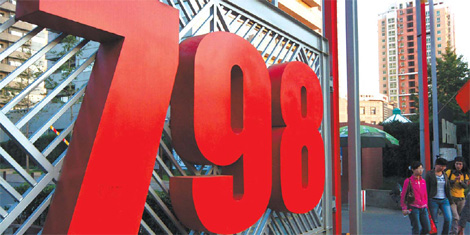Art on the move
 |
|
The 798 Art Zone, listed by Time magazine as a cultural landmark of the world, has developed into a hub of the capital's art industry over the past decade. [Wu Changqing] |
First there was Yuanmingyuan, then Songzhuang and later, the 798 Art Zone. As urbanization spreads, artists' villages are being forced to newer locations.
Yi Ling, 49, widely acknowledged as head of the Yuanmingyuan Artists' Village of the early 1990s, likens artists to nomads. "They are always hunting for new pastures to satisfy their hunger for inner peace, personal freedom, and a sense of achievement," says Yi who has witnessed the dramatic turns in the development of China's artists' villages.
In 1983, the self-taught writer and artist quit his job at a textile factory in suburban Shanghai, to embark on "a journey without a clear destination", that lasted five years.
He traveled to many parts of the country, with help from warm-hearted strangers, wrote a stack of diaries, and produced numerous sketches of the nation's ethnic groups scattered all along the route - from Shanghai to Yunnan, and from Sichuan to the Xinjiang Uygur autonomous region.
"Doing something unusual offered an alternative for young men like me to affirm that life was meaningful," explains Yi, who failed the national college entrance exam but refused to be called a loser.
Yi ended up settling at Beijing's northwest corner near Yuanmingyuan, the ruins of the Old Summer Palace in 1988.
While doing odd jobs to support himself, Yi joined art classes, attended guest lectures at Peking and Tsinghua universities, and read every book on art that he could find.
"The 1980s was an exciting time in China," Yi says. The end of the chaotic "cultural revolution" (1966-76) and the beginning of reforms opened the door to a whole new era.
Like Yi, an estimated 400 to 500 young people - mainly painters, poets and rock musicians - came from all parts of the country to settle in villages near Yuanmingyuan, leaving behind their families.
"They attracted huge attention with their bohemian lifestyles," recalls Yi, who first painted on cheap, rough paper, and later, on wooden dippers he bought from the ethnic Miao people of Guizhou.
"The artists' village opened up the possibility of finding like-minded people, cheap and quiet living, and a gentrified camaraderie", says Yang Yingshi, a Beijing-based researcher of contemporary Chinese art.
It threw up some big names such as Fang Lijun, Yue Minjun, and Yang Shaobin, whose commercial successes have garnered huge attention.
However, life was hard for most artists. "If we compare the group of artists to a pyramid, the well-known and successful ones were but the handful occupying the tip," says artist Wang Qiuren, an early inhabitant of the Yuanmingyuan Artists' Village.
Wang still remembers that his works sold at about 50 yuan ($7.3) in 1991, mostly to Beijingers and occasionally to foreign diplomats and businessmen working in the capital. Some of his neighbors had to sell Spring Festival couplets to the farmers to put food on the table.
There were no galleries for trading original works until 1991 in Beijing and 1995 in Shanghai. And it was only in 1992 that the first auction house was established in Shenzhen, Guangdong province.
Artists working for academies, production teams or factories were commissioned to produce art as part of their routine work, explains Wang who used to work in a factory in Shanghai.
"They got nothing extra. It was difficult for independent artists to earn a living by selling their works," says Wang, whose paintings sold for about 800 yuan ($117) in 1996. Now his oil paintings and experimental inks fetch at least 30,000 yuan ($4,399).
 0
0 







Go to Forum >>0 Comments